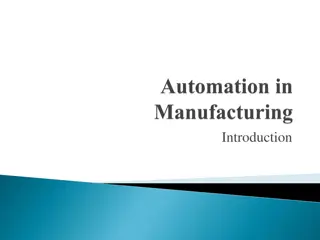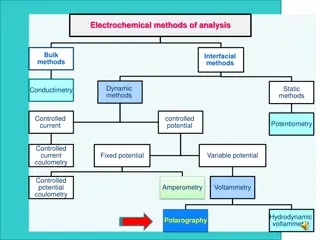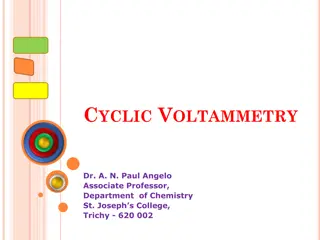Main Manufacturing Processes to Produce PM - Mechanical, Chemical, Electrochemical
The process of producing PM involves various manufacturing processes such as mechanical grinding and milling, physical-mechanical production methods, chemical production methods, and electrochemical production methods. Mechanical processes include grinding and milling using jaw crushers, hammer grinders, and ball mills. Physical-mechanical methods involve converting molten metal into powders through atomization techniques. Chemical and electrochemical methods are also utilized in the production of metal powders.
Uploaded on Nov 27, 2024 | 5 Views
Download Presentation

Please find below an Image/Link to download the presentation.
The content on the website is provided AS IS for your information and personal use only. It may not be sold, licensed, or shared on other websites without obtaining consent from the author.If you encounter any issues during the download, it is possible that the publisher has removed the file from their server.
You are allowed to download the files provided on this website for personal or commercial use, subject to the condition that they are used lawfully. All files are the property of their respective owners.
The content on the website is provided AS IS for your information and personal use only. It may not be sold, licensed, or shared on other websites without obtaining consent from the author.
E N D
Presentation Transcript
Main manufacturing processes to produce PM Mechanical manufacturing processes Physical-mechanical production methods Chemical production methods Electrochemical production methods 1. 2. 3. 4.
1. Mechanical manufacturing processes 1.1. Grinding To grind a sintered sponge metal from reduction and electrolytic processes, jaw and hammer crushers are used above all. Grinding in a jaw crusher is performed between a fixed jaw and a moving one (Fig. 1) and represents the first stage of disintegration, where a coarse powder is obtained. This is subsequently milled to a final product in some type of a mill. In a hammer grinder the material is crushed using an impact of hammers attached on a rotor. Figure (1) Jaw crusher principle
1.2. Milling The simplest device is a ball mill where milling is performed by mechanical impacts of hard milling objects carried up by a rotary motion of a drum onto the disintegrated powder. The milling objects, balls, rollers or rods inserted into the milling drums, are manufactured from unalloyed and stainless steel, pottery, agate, hardmetal etc. depending on hardness, milling capability and demanded cleanliness of powders. Milling can be carried out dry or wet, whereas the application of a suitable surface active liquid makes the disintegration easier. The work needed for the disintegration can be formulated as follows: DA = DS g where DS enlargement of a surface area (m2) and g surface stress (N/m) Surge stress s needed to disintegrate a brittle material when milling depends on a structure of imperfections and susceptibility to the crack propagation: s = (2 E r/D)1/2 where E Young s modulus; r a radius of a tip of an existing crack or defect; D a particle size
In wet milling the liquid prevents the formation of larger secondary particles and, moreover, a decrease of the liquid adsorption on the particles surface. By this a necessary output of the aggregate can be decreased or fineness of particles can be enhanced. For very intensive grinding the so-called atritors are used (Fig. 2), where a motion of the milled material (grist) and milling balls is achieved by a agitating element and circulation pump providing a circulation of the liquid with powder. The disintegration is carried out by friction between the grist and milling balls. value occurs as a result of the Figure (2) Attritor for intensive material milling
2. Physical-mechanical production methods This method involves the conversion of molten metal into a spray of droplets that solidify into powders. It is the most versatile and popular method for producing metal powders today, applicable to almost all metals, alloys as well as pure metals. Properties of the obtained particles (size, shape, morphology, structure...) are determined by many factors and their mutual combinations: the melt temperature; the melt viscosity and surface stress; cooling conditions; atomization conditions. There are multiple ways of creating the molten metal spray, which include: gas atomization water atomization centrifugal atomization 1. 2. 3.
2.1. gas atomization a high velocity gas stream (air or inert gas) is utilized to atomize the liquid metal. In figure (a) below, the gas flows through an expansion nozzle, siphoning molten metal from the melt below and spraying it into a container. The droplets solidify into powder form. In a closely related method shown in figure (b) below, molten metal flows by gravity through a nozzle and is immediately atomized by air jets. The resulting metal powders, which tend to be spherical, are collected in a chamber below.
2.2. water atomization a high-velocity water stream is used instead of air and is the most common of the atomization methods, particularly suited to metals that melt below 1600C (2900F). Cooling is more rapid, and the resulting powder shape is irregular rather than spherical. The disadvantage of using water is oxidation on the particle surface. A recent innovation involves the use of synthetic oil rather than water to reduce oxidation. In both air and water atomization processes, particle size is controlled largely by the velocity of the fluid stream; particle size is inversely related to velocity.
2.3. centrifugal atomization Several methods are based on centrifugal atomization. In one approach, the rotating disk method shown in Figure below, the liquid metal stream pours onto a rapidly rotating disk that sprays the metal in all directions to produce powders.
The melt atomization methods using the centrifugal force can be divided to one-stage and two- stage processes. - The basic methods using the one-stage process include the Rotation Electrode Process (REP) and the Plazma Rotating Electrode Process (PREP). - The REP method comprises an apparatus where two electrodes are placed an anode of the appropriate alloy of which the powder is made and a tungsten cathode. - By applying a voltage, an arc occurs between the electrodes and the alloy electrode surface becomes smelted. - By rotating this electrode (1000 to 20000 rpm) the smelted metal drops are sprayed inside a tank which has a cooled outer surface.
- The two-stage process involves melting of the given metal or alloy (for instance with the help of the induction heating in a melting crucible) and the melt disintegration with the aid of a quickly rotating cooled wheel, disc or crucible separately in two steps. A problem in the two-stage process is a transmission of the high rotational speeds to the melt. This atomization method is used for a manufacture of powders of aluminium, titanium alloys, superalloys and high- melting point metals.
Figure below: A shape and a structure of particles obtained by various methods of the melt atomization























